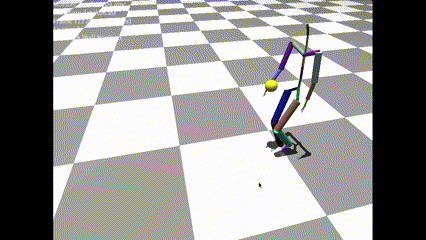Traditional Animation : Inverse Kenematic
Introduction: C++ implmentation of inverse kenematic
Goal
Implement two procedural animation techniques (CCD and Transpose Jacobian) Compare results between two methods
Technique - CCD
Cyclic Coordinate Descent Inverse Kinematics
Main idea:
align one joint with the end effector and the target at a time, so that the last bone of the chain iteratively gets closer to the target.
Algorithm:
| |
Video:
Technique – Jacobian Transpose IK(3DOF)(Numerical Approach)
Main idea : Jacobian Matrix
$ 𝐽∆ \theta= ∆𝑒 $
$ 𝐽^{−1}𝐽∆ \theta = 𝐽^{−1}∆𝑒 $
$ ∆ \theta= 𝐽^{−1}∆𝑒 => 𝐽^T∆𝑒 $
Algorithm:
| |
Video:
Result Compare
- CCD method moves faster than Jacobian IK
- Jacobian IK is smoother than CCD
- CCD will take more time to converge to best approximation
Discussion
- My version of Jacobian IK don’t seriously think of picking a good scalar value α
- My Jacobian IK treats all joint with 3DOF
- Thinking of trying more Jacobian option (like pseudo-Jacobian, Damped least squares)
- Analytical Jacobian Method is hard to think when facing more than 1 DOF robotic arm
